
Mining & Metals 2021: ESG momentum reaching a crescendo in a resilient market
Miners spent 2020 navigating the unprecedented challenge of COVID-19, and their resilience shone through. ESG was a dominant force but what should we expect as we head into 2021?
14 min read
World in Transition
Our views on changing dynamics in energy, ESG, finance, globalization and US policy.
From being seen as an existential threat for the mining & metals industry at the beginning, the COVID-19 pandemic turned into a resilience story for the sector
The global COVID-19 pandemic dominated every aspect of business, politics and economics in 2020, and it was no different for the mining & metals sector. Yet what started as being seen as an existential threat, with stock prices collapsing to the lowest since the commodity crisis in 2015, soon morphed into a resilience story for the industry.
45.4%
Respondents to our 2021 Mining & Metals market sentiment survey believe that ESG issues will be the key risk for the sector in 2021
The majors proved incredibly robust, being able to keep the world's biggest mines operating and in most cases their staff safe. Global supply chains held up (mostly) and China managed to keep its industrial engine humming, driving demand for metals and commodities.
As the year drew to a close, copper and iron ore traded at the highest levels since the 2013 commodities boom, while gold rose above US$2,000 per ounce for the first time. Anecdotal evidence suggests that the resilience of the industry, combined with growing investor excitement about the metals needed for the green revolution, brought generalist investors back to the sector for the first time in years, while the biggest miners continue to promise to deliver record returns back to shareholders.
There was also, as rightly predicted by our 2020 mining & metals survey, an increasing focus on the importance of ESG in the sector, with concerns over emissions and the continued mining of thermal coal coming to the fore. The forced departure of Rio Tinto's CEO, and other executives, after the destruction of two ancient Aboriginal heritage sites, also showed that this is an issue bigger than just climate change and pollution. This follows increased scrutiny around tailings dams following the Brumadinho dam collapse in Brazil in 2019.There is currently a global inquiry into the status of more than 700 dams ongoing, while investors are demanding ever-increasing disclosures from companies on the issue.
Against this backdrop, what should we expect as we head into 2021? To get an idea, White & Case has conducted its fifth annual survey of industry participants, with 68 senior decision makers sharing their thoughts for the year ahead.
Overcoming a global pandemic
Coronavirus dominated the actions and thoughts of all stakeholders in the mining & metals space last year, and this theme is expected to continue into 2021. However, our respondents expect that the sector will be able to continue to navigate the ongoing crisis.
In the spring, concerns grew that major mines would have to be shut down, especially in crucial jurisdictions like South Africa and Chile. Yet despite government policies limiting the number of people that could work underground, the miners were able to keep operations running. As restrictions were lifted, the industry surprised many with the speed at which production was able to come back on line, with most of the big companies returning to full production schedules by the third quarter.
Concerns about widespread demand destruction also went unrealised. Chinese demand for many commodities, including copper, rose to record highs through the summer and autumn as the biggest consumer of metals recovered from a slowdown earlier in the crisis.
Responses from our survey indicate that this is set to continue. Just 7.5 per cent said that COVID-19-led demand destruction would be the biggest threat to the sector this year, while only 13.6 per cent saw its impact on supply chains being the biggest risk. ESG was by far the most frequent selection, taking 45.4 per cent of the vote.
As COVID-19 restrictions were eased in late spring/early summer 2020, the industry surprised many with the speed at which production was able to come back online, with most of the big companies returning to full production schedules by the third quarter
Copper remains top pick
Nothing demonstrated mining & metals' renewed fortunes more than copper last year, as predicted in our January 2020 survey. The metal, crucial in everything from electric cables to water pipes, jumped to the highest price in seven years after going on a nine-month winning streak prompted by increasing investor concern that the metal would enter a deficit in the coming years, as constrained supply met soaring demand from new industries such as electric vehicles and green infrastructure and technology.
The market's enthusiasm for copper is again reflected in our survey. The metal was the most favoured to outperform this year, with 36 per cent picking it to be the standout metal of 2021, matching last year's prediction and double the number that picked gold, the second-most favoured metal in our survey.
For the miners, copper's rally was especially good news. As prices surged, input costs fell, creating the biggest margins for miners in years. Currencies in major producing countries, such as Chile, weakened against the US dollar, while oil prices, a key cost input, also fell steeply, making the metal highly profitable for the producers. This was reflected in share prices, especially pure-play producers like Antofagasta and Freeport-McMoRan, which both jumped to multi-year highs.
A further boost for copper may come from Biden's victory, especially now his party controls the Senate, paving the way for a sizeable stimulus package with a decarbonisation agenda. Copper, nickel, cobalt and lithium—all critical commodities needed for the increased electrification of cities and batteries for electric vehicles—stand to benefit from an acceleration of the energy transition.
US$160
Iron ore prices jumped above $160 per tonne in January 2021
Iron ore an unexpected bright spot
The other big success story for the miners was iron ore. Despite many industry participants and investors continuing to view the steelmaking ingredient bearishly, it jumped to the highest levels in seven years. Our respondents also underestimated its strength, with just 3 per cent picking the commodity last year as the most likely to outperform and 4 per cent picking it to do well in 2021.
Yet despite the consistent gloom, the material continues to rally. Vale, the world's biggest producer of iron ore and pellets, has seen very strong demand from China while at the same time reducing its production target for 2020. BHP Group and Rio Tinto are also facing potential restrictions after the fallout from the Aboriginal cave destruction, stoking fears of a shortage of iron ore. The commodity has also benefited from the continued focus on anti-pollution policies in China—reinforced in its latest Five- Year Plan—which has stoked demand for higher-quality iron ore and coking coal. Political tensions between China and Australia also need to be monitored, as noted by one of our respondents; for the time being, iron ore exports may well remain unaffected given their importance to both nations, but it's certainly a risk factor in the event of a significant rise in regional tensions.
The combination of supply worries and record Chinese demand has created a boon for the biggest miners who were already delivering record shareholder returns through dividends and buybacks. That theme is set to continue when full-year results are posted in February, as investors reap the rewards of the sector's continued discipline on deals and capital expenditure.
80%
The upside potential for platinum prices in 2022 and beyond, with analysts predicting the rise of up to US$1800/oz in 2022
The return of the generalist investor?
This resilience to COVID, combined with surging commodity prices and a focus on shareholder returns, appears to be encouraging generalist investors back to the space. Only 21.6 per cent of our respondents expect generalists to remain wary of the sector, down from around a third in the previous two years.
Instead, continuing to focus on shareholder returns is seen as the sector's best way to keep this trend going. For context, the sector comfortably outperformed the MSCI All Country World Index last year, and in weaker-performing equity markets such as the UK, which has far less exposure to the tech-growth which lifted the ACWI, the sector was among the top-three performers in the 41-sector FTSE 350 index. In addition, our respondents also identify other areas that can draw in generalists, including offering natural resource exposure without oil & gas and improved ESG performance. In total, some 78.4 per cent of respondents see potential for generalists to be drawn to the sector.
There is no doubt that the ESG agenda is now centre stage. Investors are driving change at a pace that far outstrips regulators
Survey participant, White & Case 2021 Mining & Metals market sentiment survey
ESG dominates the agenda
ESG matters are not new to the mining sector. While essential to our modern world, the mining space by its very nature is always going to face very intense scrutiny on this front. But even by recent standards, 2020 set a new bar for what is expected and, perhaps most importantly, for what is not acceptable.
Perhaps the biggest story in the industry last year—aside from the pandemic—was the departure from Rio Tinto of three key executives following accusations of failing to act on information that the two heritage sites had greater significance than initially realised. CEO Jean-Sebastien Jacques and two key deputies were forced to step down in September after a furious backlash from investors that criticised the company's initial response to the blasts and tame penalties.
The departure of a CEO who had delivered record shareholder returns and overseen the company's share price hit multi-year highs added further evidence of the increasing importance investors, communities, regulators and other stakeholders place on ESG matters. Our survey last year flagged this risk, with almost half of respondents choosing local community impact as the biggest area of mining & metals that would face the most scrutiny from both investors and regulators.
This year, some 78.8 per cent expect ESG issues to play a greater part in investors' decision-making, while ESG performance is also seen as the industry's second-most important priority for this year, after ensuring production can be maintained in the face of the pandemic. As one respondent said, "investors are driving change at a pace that far outstrips regulators," while another more colourfully put it, "ESG has hit the investor community like a train and will drive material change in behaviours in the near term that will impact the sector in many regards." Accessing equity may be more challenging, which could restrict project ambitions and change how financing packages are structured, the respondent said.
US$ 17.16bn
Total value of global mining & metals M&A in H1 2020
Source: GlobalData's deals database
The journey towards carbon neutrality
Our survey highlights emissions and pollution as the most important ESG issues, but respondents were split on where the most focus will be: Scope 1 and Scope 2—when pollution is created by the miners' operations, and Scope 3—the pollution created when the materials they mine are used by their customers.
Scope 1 and Scope 2 emissions are relatively small for the mining sector compared to Scope 3, and also easier to address, as highlighted by our survey. BHP, Rio Tinto and Anglo American have all set out targets to become carbon neutral by between 2040 and 2050 at their own operations, yet the three miners have yet to find a solution for their Scope 3 emissions, the majority of which come from their highly profitable iron ore divisions.
So far, Glencore is the only major to have found a pathway to being carbon neutral by 2050 that includes Scope 3 emissions. This is because it mines no iron ore and plans to be mostly thermal coal-free in 30 years. Still, its giant thermal coal operations remain a concern for many investors, despite the commodity trader providing a roadmap to eventually transitioning away from the dirtiest fuel.
In our survey, 25.5 per cent of respondents said the miners would face the most scrutiny on Scope 1 and Scope 2, while 23.5 per cent said Scope 3 emissions would attract the most investor attention in terms of ESG issues. Local community impact was again prominent, capturing 21.5 per cent of the poll, highlighting the fallout from Rio's cave destruction. One respondent stressed the need for greater cultural expertise at the board and executive levels, especially with much of the future demand coming from emerging markets. Tailings management and safety received less focus, but given the recent tailings dam accident in Brazil, this topic is likely to remain of important focus for the sector.
The ongoing realisation, in-house, that mining brands & culture need to be B2C friendly while remaining B2B focused will be one of the most pervasive themes of 2021
Survey participant, White & Case 2021 Mining & Metals market sentiment survey
One important point raised in the survey was the feeling that the sector must be front-footed in explaining its crucial role in the energy transition, and to define precisely what sustainability means for the extractive sector. Otherwise, there exists the risk that the cost of capital could increase for the sector as a whole as regulators could demand a higher return on capital employed for sectors not deemed sustainable—without perhaps having the full picture.
This of course needs to be done properly, with one respondent noting that "improper efforts to influence corporate governance and cost increases resulting from knee-jerk ESG efforts" need to be challenged. Such a crucial element of a company's strategy cannot be seen as a box-ticking exercise; as another participant noted, "mining brands and culture need to be business-to-consumer friendly while remaining business-to-business focused." This will help maintain strong relationships with stakeholders ranging from governments, influential equity and debt holders in addition to local communities, all of which will help the effort to attract an increasingly ESG-minded institutional investor base.
US$ 2,000
Gold prices hit a record rising above US$2,000 per ounce in 2020
Gold surges; outlook is mixed
Gold's rally to more than US$2,000 an ounce in August, fuelled by investors looking for a safe haven from the economic fallout of the pandemic, was a major boost for the industry.
The gold sector has transformed itself in recent years, following Barrick Gold and Newmont Gold's transformational transactions. Many smaller producers have responded with a wave of mergers as they attempt to stay relevant to investors who have preferred the scale offered by the dominant new producers.
Our survey shows that this surge in gold deals is expected to continue. More than 40 per cent said they expected precious metals to be the sector most likely to see consolidation this year, almost double the number of votes for base metals, which came in second in the poll. Still, while our respondents expect deals, they are spilt on the outlook for bullion this year. While it was the second-most favoured commodity to outperform this year, receiving 18 per cent of the ballot, it was also the second-most favoured to underperform, with only coal seen as more likely to fall this year in our survey.
Last year was also notably strong for platinum group metals, especially palladium and rhodium, as fears of supply deficits grew. This was compounded by some mine shutdowns in South Africa, and it was one of the few commodities that suffered significant production impacts from COVID-19.
Cu
Copper is expected to outperform other mining commodities in 2021, according to our survey respondents
Big deals outside gold unlikely
Once again, our survey shows that big deals are not expected outside of the gold space. Nearly half of respondents said they expected M&A to be opportunistic and focused on assets, rather than the big transformational deals that have reshaped the sector in the past. That's a similar number to last year, when participants accurately forecast that the big miners would remain gun-shy when it came to deals.
There is no doubt that the aftermath of COVID-19 will be long-lasting, and for some sectors, deeply structural. Yet the mining & metals space appears to be in relatively good shape, perhaps benefiting from having its pool of crisis management experience enriched by the downturn in 2015. With prices of key commodities elevated, and core customers such as China bouncing back far more swiftly than the West, the sector can get back on the path it was on as we entered this new decade. ESG is an even more dominant force, and if the industry can continue to provide tangible evidence of its progress on this front—in a cost-effective manner—generalist investors might continue to support the sector.
View the full results of our survey (PDF)
This publication is provided for your convenience and does not constitute legal advice. This publication is protected by copyright.
© 2021 White & Case LLP

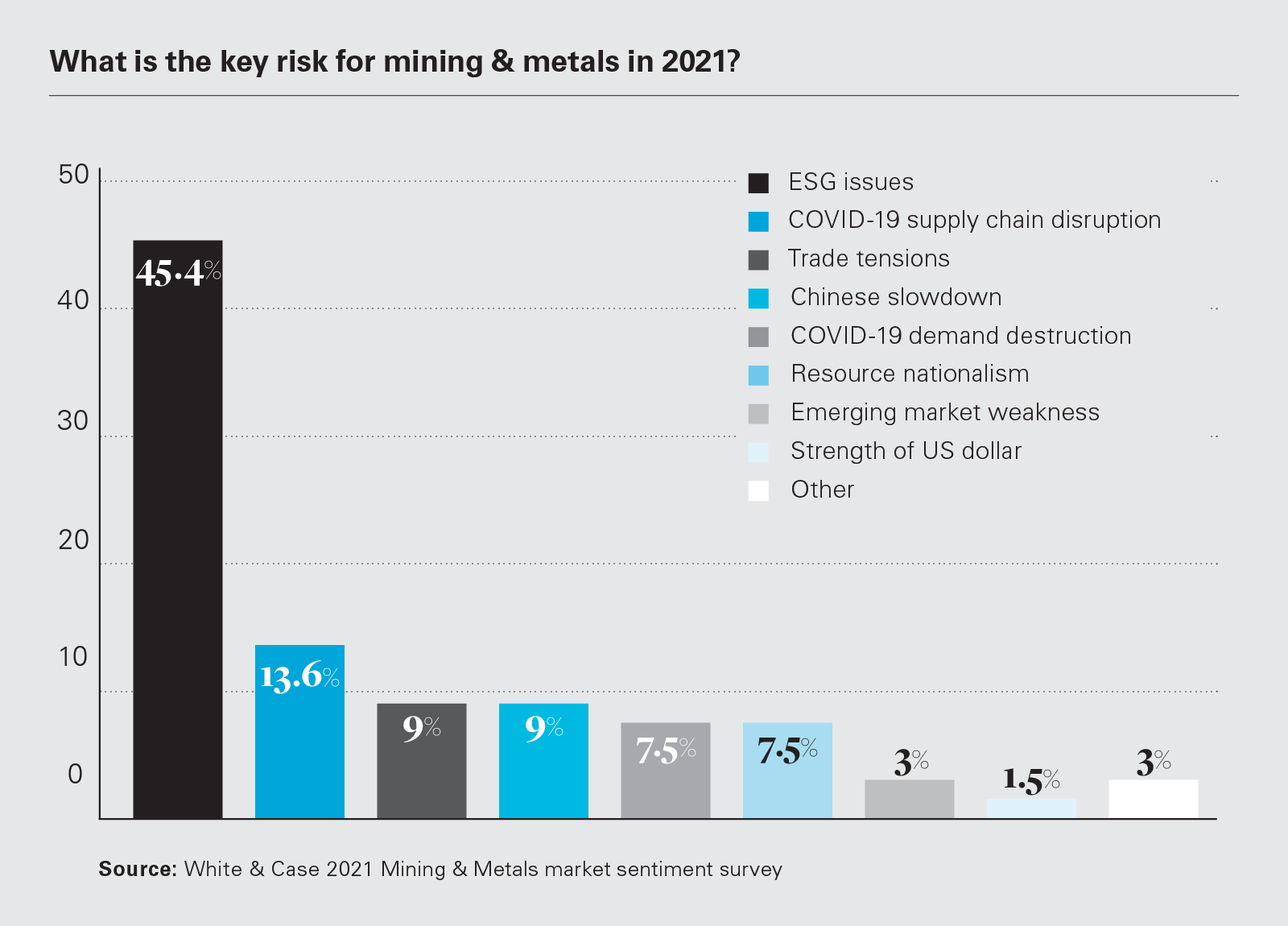 View full image: What is the key risk for mining & metals in 2021? (PDF)
View full image: What is the key risk for mining & metals in 2021? (PDF)
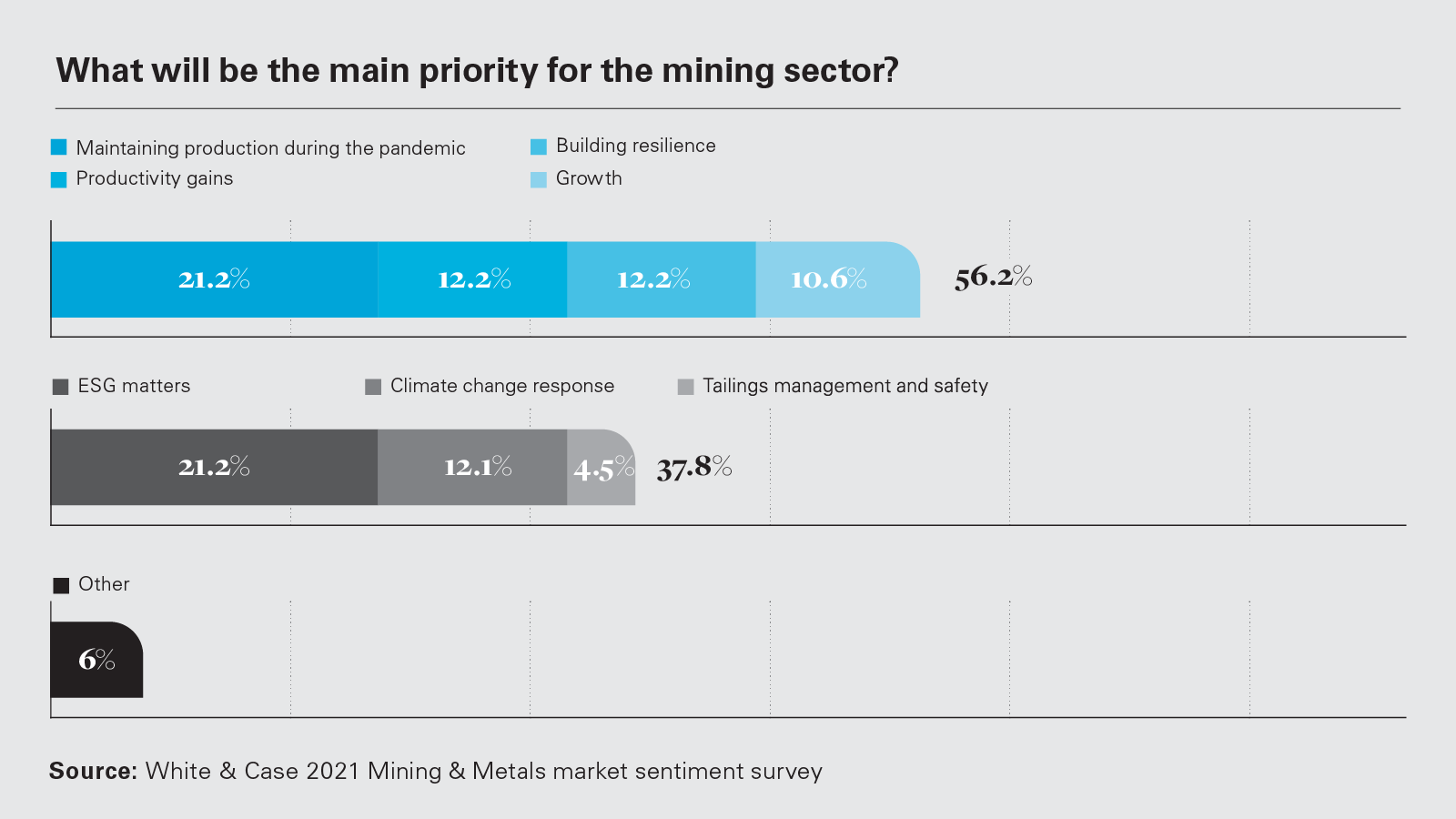 View full image: What will be the main priority for the mining sector? (PDF)
View full image: What will be the main priority for the mining sector? (PDF)
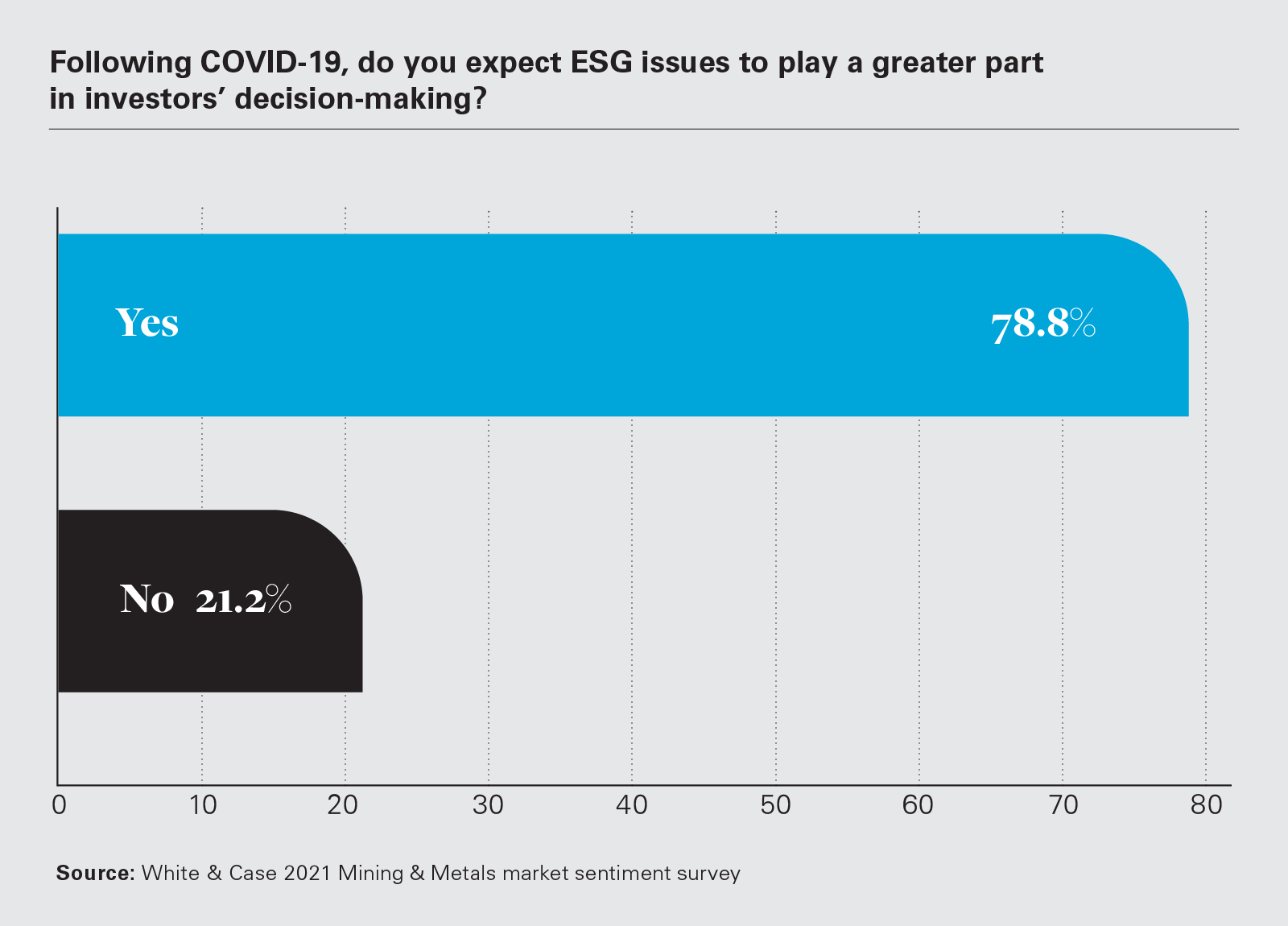 View full image: Following COVID-19, do you expect ESG issues to play a greater part in investors' decision-making? (PDF)
View full image: Following COVID-19, do you expect ESG issues to play a greater part in investors' decision-making? (PDF)
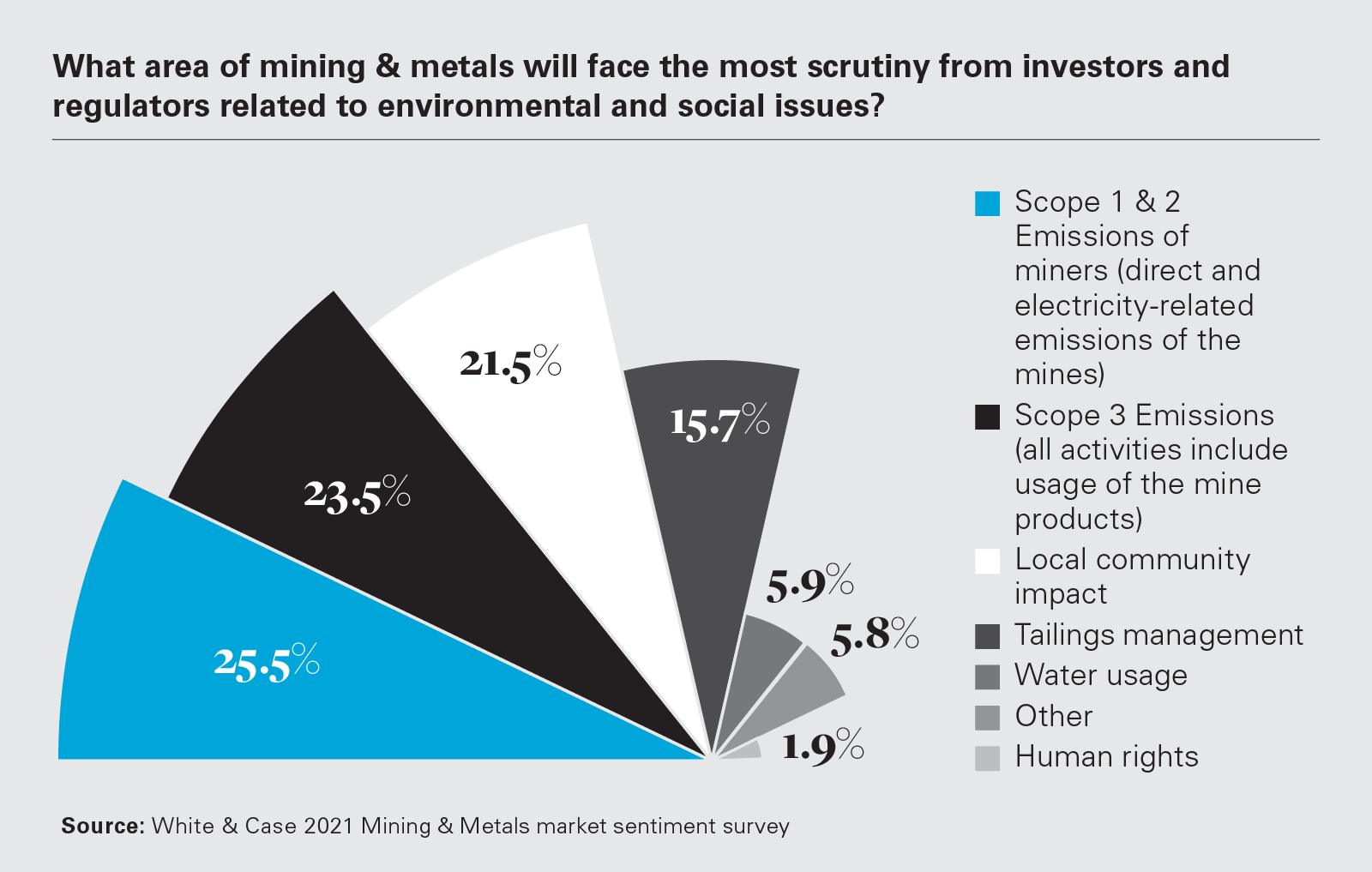 View full image: What area of mining & metals will face the most scrutiny from investors and regulators? (PDF)
View full image: What area of mining & metals will face the most scrutiny from investors and regulators? (PDF)
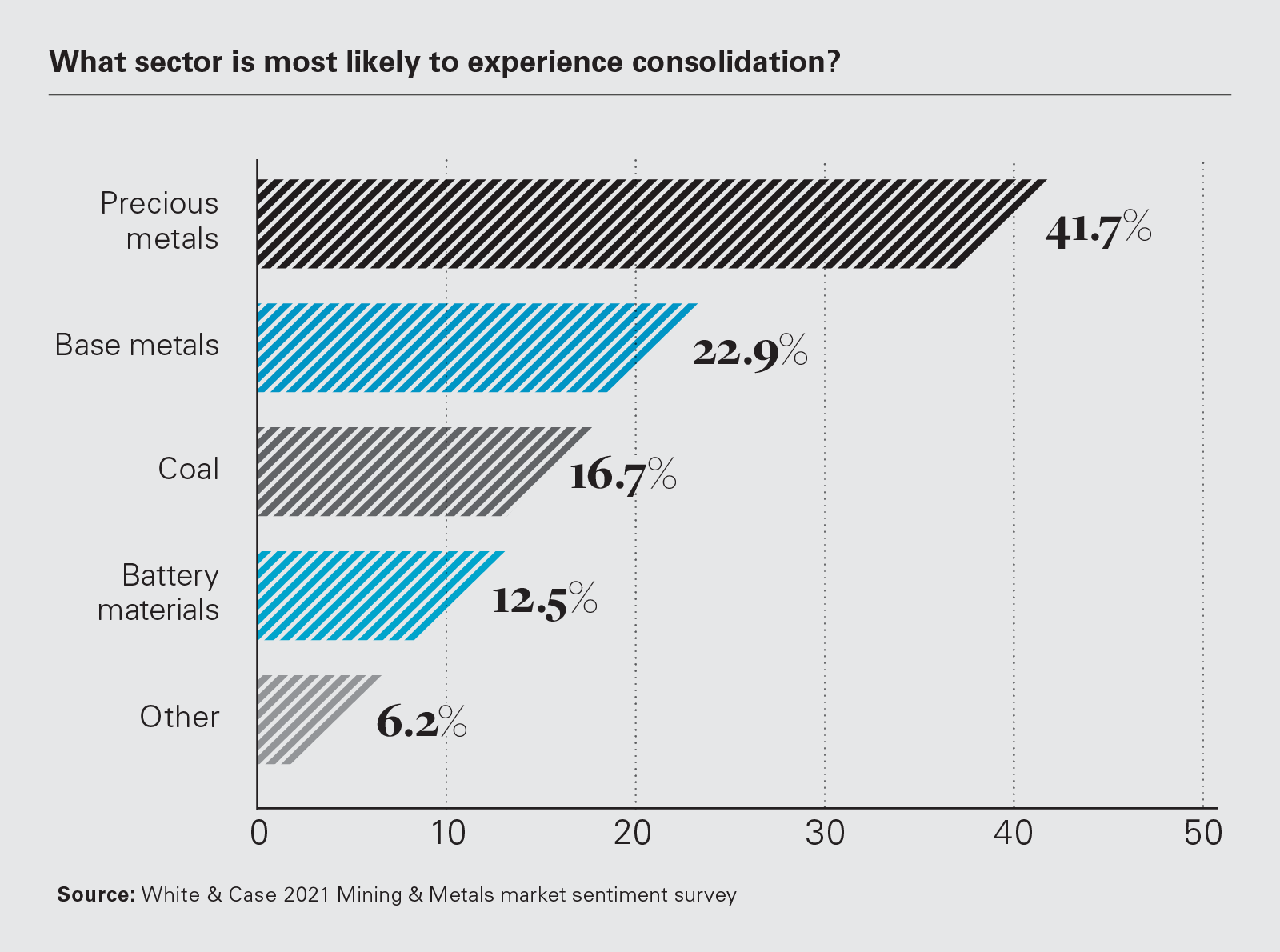 View full image: What sector is most likely to experience consolidation? (PDF)
View full image: What sector is most likely to experience consolidation? (PDF)
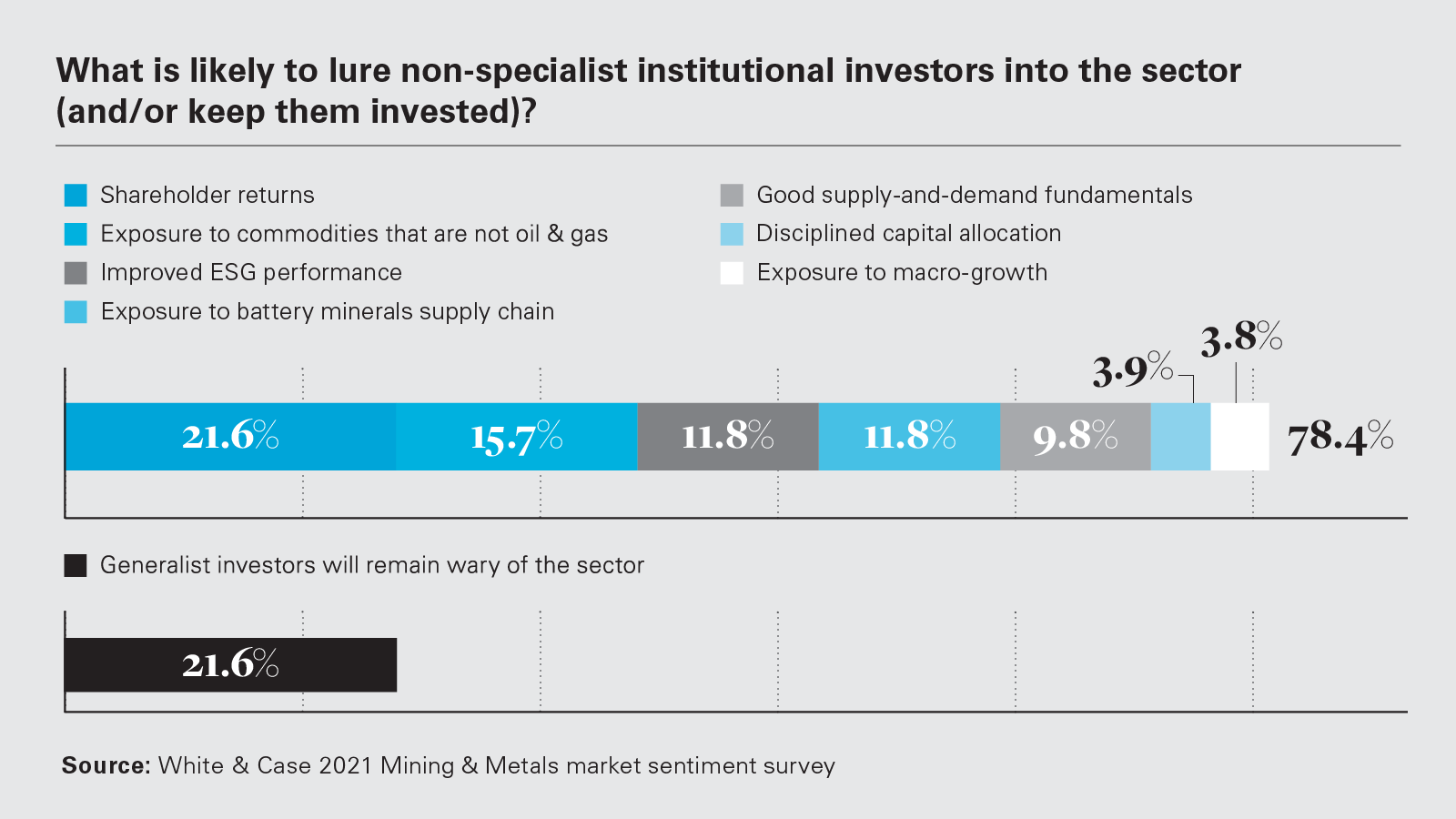 View full image: What is likely to lure non-specialist institutional investors into the sector? (PDF)
View full image: What is likely to lure non-specialist institutional investors into the sector? (PDF)
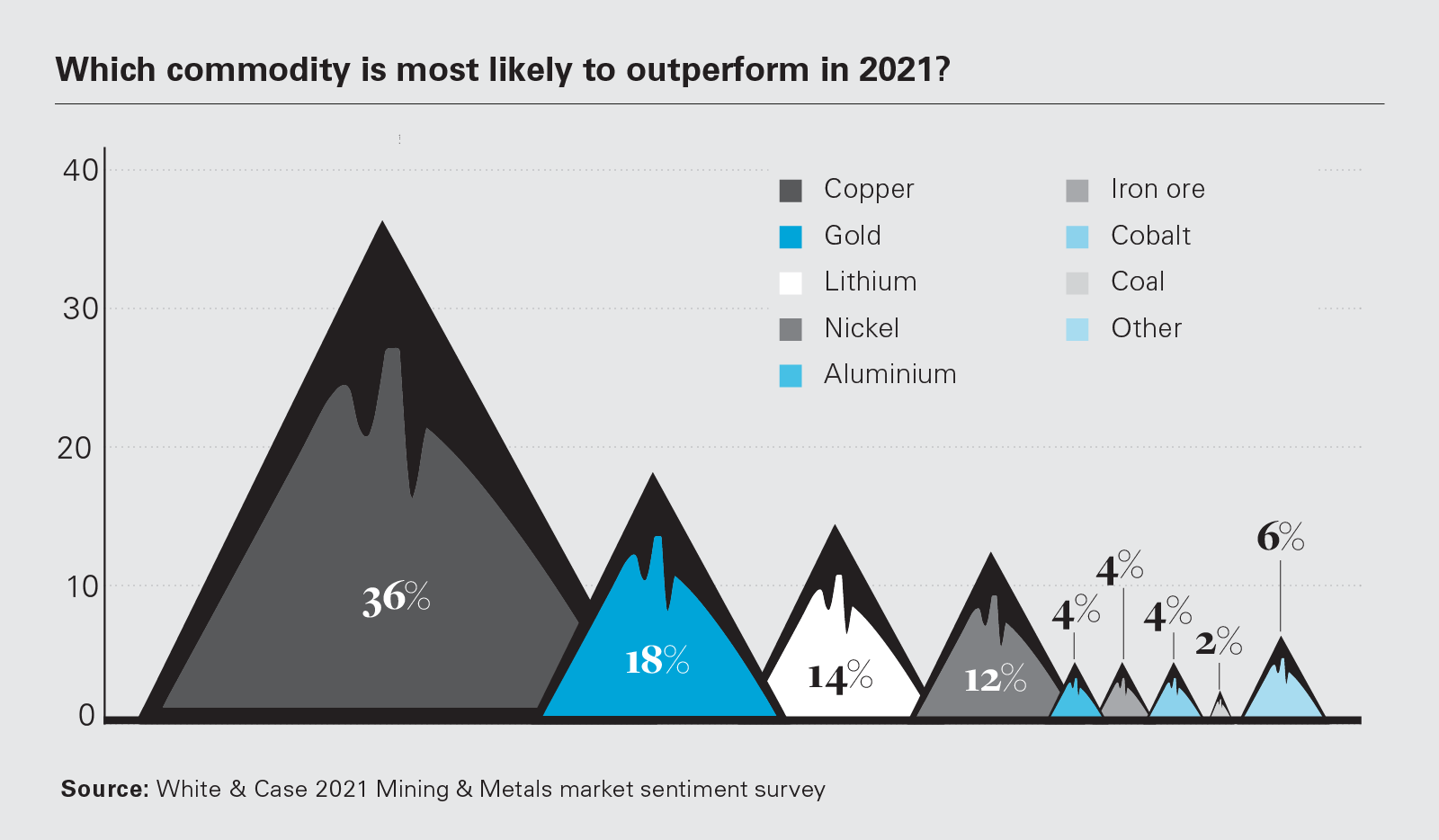 View full image: Which commodity is most likely to outperform in 2021? (PDF)
View full image: Which commodity is most likely to outperform in 2021? (PDF)

